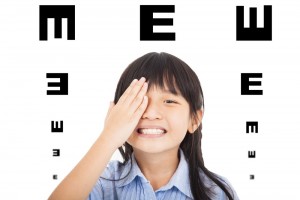
It is well-documented that at least 25% or 1 in every 4 children has a vision problem which can hinder learning. Our local experiment proves those statistics are quite understated. This is, unfortunately, because our society does not yet recognize nor require proper vision testing for our children. The Snellen eye chart, which promotes perfect vision as 20/20, was invented in 1862, over 150 years ago. It’s good for a child to see the blackboard clearly 20 feet away. But how will this help him read, comprehend and do lessons from a schoolbook or computer 1-2 feet in front of him?
In this world of advanced technology and progressive thinking, we lag far behind in understanding that NEAR vision is the key to success in today’s classrooms. It takes 17 visual skills all working optimally to have perfect near (reading) vision. The state of Illinois requires 3 of those to be tested. Under these guidelines, most of you have never had your child’s vision completely and properly examined.
Of the 287 children we screened, only 2nd and 8th grades were required to have a vision screening for school. Here are our findings from the entire school, which represents a cross-section of students across America:
- 14% of students were strabismic – crossed or misaligned eyes
- 12% failed the stereo vision test – poor depth perception (3D vision)
- 27% failed the cover test (strabismus or large phoria) – eyes were unable to remain fixed on an object or words when reading
- 52% failed the fusion and suppression test – both eyes did not work together simultaneously; or 1 eye was (lazy) not used
- 65% failed visual discrimination – lacked awareness of the distinctive features of forms including shape, orientation, size, and color
- 40% failed visual memory – inability to retain information over time
Failure in a specific area means the child has a vision weakness in that area. Depending upon what it is, it may affect school performance, specifically reading, writing and comprehension, as well as altering attitude and behavior, even presenting incorrectly as a learning disability or ADHD.
Children with strabismus and/or lazy eye experience eyestrain and discomfort while reading and studying, often causing them to develop a short attention span or avoid schoolwork altogether. Their eye-brain connection must be retrained.
A child who failed the phoria, fusion, or depth perception test has difficulty using their eyes together as a team. They need to work longer and harder to compensate in school or sports, and they may not work up to their potential.
Failing vision memory or discrimination tests may require the child to work more and study longer to retain information. The inability to distinguish similar words makes reading laborious. Memory dysfunction may cause prolonged time copying assignments or notes, and will naturally affect quiz- and test-taking, since the child labors to visually recall what was studied.
Glasses alone will not remedy these problems. Screening minimally for 3 of 17 near vision skills leaves children struggling unnecessarily in school when help is available. A behavioral optometrist can evaluate ALL areas of your child’s vision. We would test over 2 days, looking in depth at visual skills such as tracking, eye alignment, depth perception, and eye teaming the first day. Visual thinking skills like memory, discrimination, and figure ground would be tested the second day.
If we diagnose your child with a vision problem that affects learning, we offer several treatment options. We utilize photosyntonic light therapy and vision therapy to retrain the brain to control the eyes and vision more efficiently for all areas of performance. Programs are adapted specifically to your child’s needs and age level.
Please contact us if you are interested in having us give vision screenings at your school. We welcome the opportunity to provide this service and offer a solution to children toiling in school whose vision has never been thoroughly evaluated. To schedule an appointment for your child or for more information, please call the office, contact us here on our website, or visit us on Facebook.